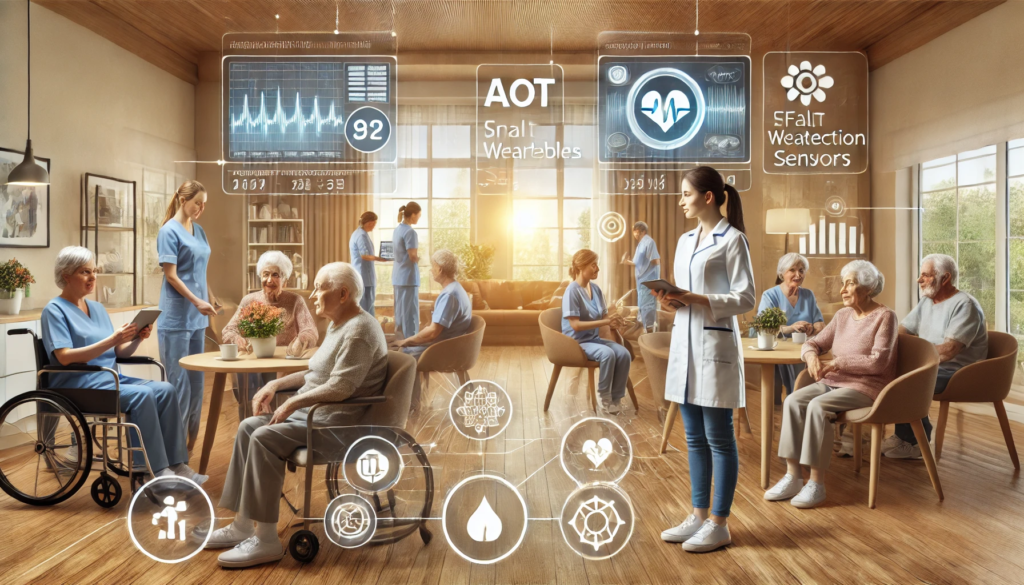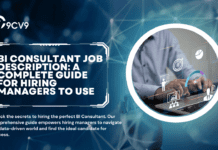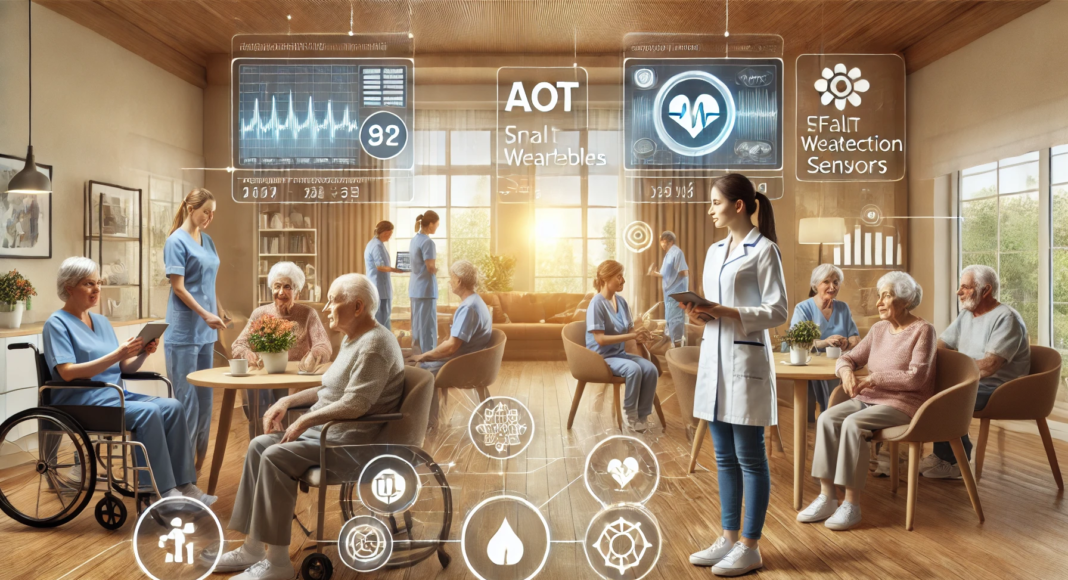Key Takeaways
- Rising Adoption of AI & Automation – Assisted living facilities are leveraging AI-powered analytics and automation to enhance resident care and operational efficiency.
- Growth of Cloud-Based & Mobile Solutions – Cloud platforms and mobile health (mHealth) apps enable remote access to patient data, improving real-time monitoring and caregiver collaboration.
- Increased Focus on Security & Compliance – With more digital solutions in use, facilities must prioritize HIPAA compliance, data encryption, and cybersecurity to protect resident information.
The demand for assisted living software is rising rapidly as the senior care industry undergoes a digital transformation.
With an increasing number of aging populations requiring specialized care, technology-driven solutions are becoming essential in managing daily operations, enhancing resident well-being, and ensuring compliance with regulatory standards.
Assisted living facilities, home healthcare providers, and senior care communities are integrating advanced software solutions to streamline administrative tasks, optimize patient care, and improve overall efficiency.

As the global senior population continues to grow, healthcare providers are leveraging AI-powered automation, cloud-based management systems, and predictive analytics to enhance care delivery and ensure better patient outcomes.
The assisted living software market is witnessing an upward trajectory, with innovations in electronic health records (EHR), medication management, remote monitoring, and AI-driven predictive analytics.
These tools not only reduce operational burdens but also facilitate personalized and proactive care for elderly residents.
Understanding the latest statistics, data, and trends in assisted living software is crucial for facility operators, healthcare professionals, and technology providers looking to optimize their services.
Industry insights reveal how advancements in cloud computing, artificial intelligence (AI), machine learning, and mobile health (mHealth) are shaping the future of senior care.
Additionally, regulatory changes, cybersecurity concerns, and the integration of Internet of Things (IoT) devices are influencing how software solutions evolve to meet the complex needs of assisted living communities.
This blog delves into the top 20 latest statistics, data, and trends in assisted living software, offering a comprehensive overview of market growth, technological innovations, and industry challenges.
Whether you’re a facility administrator, software provider, or healthcare professional, these insights will help you stay ahead in the ever-evolving assisted living technology landscape.
Before we venture further into this article, we would like to share who we are and what we do.
About 9cv9
9cv9 is a business tech startup based in Singapore and Asia, with a strong presence all over the world.
With over nine years of startup and business experience, and being highly involved in connecting with thousands of companies and startups, the 9cv9 team has listed some important learning points in this overview of the Top 20 Latest Assisted Living Software Statistics, Data & Trends.
If your company needs recruitment and headhunting services to hire top-quality employees, you can use 9cv9 headhunting and recruitment services to hire top talents and candidates. Find out more here, or send over an email to [email protected].
Or just post 1 free job posting here at 9cv9 Hiring Portal in under 10 minutes.
Top 20 Latest Assisted Living Software Statistics, Data & Trends
- The global Assisted Living Software market, currently valued at USD 10.2 million in 2023, is forecasted to grow significantly, reaching an estimated USD 27.5 million by 2030, driven by a robust compound annual growth rate (CAGR) of 13.34% during the forecast period.
- In North America, the Assisted Living Software market is projected to expand from its valuation of USD 19.19 billion in 2024 to an impressive USD 36.33 billion by 2032, reflecting a steady CAGR of 8.30% over the analysis period.
- The global Assisted Living Technologies sector is anticipated to grow from USD 7.82 billion in 2024 to approximately USD 9.13 billion by 2025, showcasing a remarkable CAGR of 16.8% as demand for advanced care solutions rises.
- By the year 2029, the Assisted Living Technologies market size is expected to reach a substantial valuation of USD 16.74 billion, growing at an impressive CAGR of 16.4% from previous years.
- The global ambient assisted living and smart home market, valued at USD 132.12 billion in 2024, is predicted to experience exponential growth at a CAGR of 30.8%, reaching a staggering USD 645.19 billion by 2030.
- The Assisted Living Software market is expected to witness an incremental growth of approximately USD 682.51 million between 2023 and 2028, with an accelerated CAGR of 15.9%, reflecting increasing adoption across care facilities.
- Market projections indicate that the global Assisted Living Software industry will grow from its current size of USD 332.3 million in 2024 to a significant valuation of USD 755.8 million by 2031, supported by a CAGR of 11.78%.
- North America is expected to dominate the global ambient assisted living and smart home market in 2024, accounting for approximately 33.1% of the total market share, driven by technological advancements and aging demographics.
- Revenue generated by the Assisted Living Software sector globally is anticipated to reach approximately USD 3.2 billion by the year 2033, underscoring its growing importance in elder care management.
- The increasing elderly population worldwide, projected to rise substantially in the coming decade, is one of the primary drivers behind the growing demand for Assisted Living Software solutions aimed at improving care delivery.
- The integration of advanced technologies such as Artificial Intelligence (AI) and Internet of Things (IoT) into Assisted Living Software systems is expected to enhance operational efficiencies and revolutionize care standards across facilities.
- Electronic Health Records (EHR) systems are predicted to dominate the North American Assisted Living Software market segment, contributing significantly to revenue growth through improved data management capabilities.
- Remote patient monitoring systems within assisted living facilities are witnessing increased demand due to the rising prevalence of chronic diseases among aging populations globally.
- Cloud-based Assisted Living Software solutions are gaining popularity due to their scalability and cost-effectiveness, making them an attractive choice for assisted living facilities aiming for seamless operations.
- By early 2025, it is estimated that over 50 million seniors aged over 65 years will reside in North America alone, further amplifying the need for innovative assisted living technologies and software solutions.
- Facilities adopting automation through Assisted Living Software report achieving annual cost savings exceeding 20%, highlighting its potential for improving financial efficiency while maintaining high-quality care standards.
- A recent survey revealed that around 75% of assisted living facilities plan to implement new software solutions within the next two years, indicating a strong trend toward modernization and digital transformation in eldercare management.
- The global demand for medication management software within assisted living settings continues to grow as healthcare providers emphasize medication adherence among older adults with complex health needs.
- The percentage of assisted living facilities utilizing integrated software systems combining functionalities like EHRs, billing, and scheduling has increased from approximately 40% in 2020 to an estimated 70% by early 2025, reflecting rapid digital adoption.
- By leveraging analytics tools embedded within Assisted Living Software platforms, care facilities can improve resident outcomes by as much as 30%, thanks to better resource allocation and enhanced care coordination strategies.
Conclusion
The assisted living software industry is undergoing a significant transformation, driven by advancements in artificial intelligence (AI), cloud computing, machine learning, and predictive analytics. As the global aging population continues to rise, assisted living facilities, senior care communities, and healthcare providers are increasingly adopting technology-driven solutions to enhance operational efficiency, improve patient care, and ensure regulatory compliance. The latest statistics and trends highlight how software innovations are reshaping the way facilities manage their residents, staff, and overall workflows.
One of the most notable trends in assisted living software is the integration of electronic health records (EHR), medication management systems, and real-time monitoring solutions. These features not only streamline administrative tasks but also help caregivers provide more personalized and proactive care. Additionally, cloud-based platforms and mobile health (mHealth) applications are enabling remote access to vital patient data, allowing caregivers and family members to stay informed about a resident’s health status at all times.
The role of artificial intelligence (AI) and automation is also becoming increasingly prominent in assisted living facilities. AI-powered analytics can predict potential health risks, detect early signs of cognitive decline, and recommend tailored care plans based on individual needs. This predictive approach is transforming elderly care from reactive to proactive, ensuring better health outcomes while reducing hospital readmissions and emergency interventions.
Security and compliance remain critical concerns in the assisted living industry, especially with the increasing use of cloud-based solutions and IoT-connected devices. Facilities must adhere to HIPAA (Health Insurance Portability and Accountability Act) regulations, data privacy laws, and cybersecurity best practices to safeguard sensitive resident information. The growing emphasis on cybersecurity measures, encryption protocols, and AI-driven threat detection is helping to mitigate risks associated with data breaches and unauthorized access.
As the demand for smart home technology and IoT-enabled healthcare solutions increases, assisted living software is evolving to support features like voice-activated assistants, remote monitoring systems, and fall detection sensors. These innovations enhance resident safety, improve communication between caregivers and patients, and enable independent living for seniors who require minimal supervision. The seamless integration of these technologies into assisted living environments is shaping a future where elderly individuals can enjoy greater autonomy, enhanced comfort, and higher quality of life.
Looking ahead, the assisted living software market is expected to continue its rapid expansion, fueled by ongoing technological advancements, regulatory shifts, and growing investments in healthcare IT. As more facilities embrace AI-driven automation, telehealth integration, and data-driven decision-making, the industry will witness a higher level of efficiency, accuracy, and personalized care delivery.
For assisted living facility administrators, healthcare providers, and technology developers, staying informed about the latest statistics, data, and trends is essential for adapting to the evolving landscape of elderly care technology. By leveraging cutting-edge software solutions, facilities can optimize their operations, enhance patient satisfaction, and ensure compliance with industry standards. As innovation continues to drive the assisted living sector forward, the future holds promising opportunities for smarter, safer, and more efficient senior care solutions.
If you find this article useful, why not share it with your hiring manager and C-level suite friends and also leave a nice comment below?
We, at the 9cv9 Research Team, strive to bring the latest and most meaningful data, guides, and statistics to your doorstep.
To get access to top-quality guides, click over to 9cv9 Blog.
People Also Ask
What is assisted living software?
Assisted living software is a digital solution designed to help senior care facilities manage resident care, staff scheduling, medication tracking, and compliance.
Why is assisted living software important?
It enhances operational efficiency, improves resident care, ensures regulatory compliance, and reduces administrative workload for caregivers and facility managers.
What are the key features of assisted living software?
Common features include electronic health records (EHR), medication management, staff scheduling, billing, resident tracking, and real-time monitoring.
How does AI impact assisted living software?
AI enables predictive analytics, automates administrative tasks, enhances resident care plans, and improves security through real-time monitoring and anomaly detection.
What are the latest trends in assisted living software?
Trends include AI-powered automation, cloud-based management systems, IoT integration, telehealth support, and advanced cybersecurity measures.
How does cloud computing benefit assisted living facilities?
Cloud-based solutions allow for secure, real-time access to resident data, improve collaboration among caregivers, and reduce IT maintenance costs.
What role does IoT play in assisted living software?
IoT devices help monitor residents’ health, track movement, detect falls, and provide real-time alerts to caregivers for immediate response.
How does assisted living software improve medication management?
It ensures accurate medication tracking, reduces errors, sends automated reminders, and integrates with pharmacy systems for better prescription management.
What are the security risks associated with assisted living software?
Risks include data breaches, unauthorized access, cyberattacks, and compliance violations if proper encryption and security protocols are not implemented.
How can facilities ensure HIPAA compliance with assisted living software?
By using encrypted data storage, secure access controls, audit logs, and regularly updating software to comply with evolving healthcare regulations.
Is assisted living software customizable?
Yes, many providers offer customizable solutions that can be tailored to meet the specific needs of different senior care facilities.
How does predictive analytics enhance senior care?
Predictive analytics helps identify health risks early, improves care planning, reduces hospital visits, and ensures proactive interventions.
Can assisted living software integrate with other healthcare systems?
Yes, many platforms integrate with EHRs, telehealth services, pharmacy systems, and billing software to streamline operations.
What are the cost benefits of using assisted living software?
It reduces administrative costs, minimizes errors, improves efficiency, and enhances care quality, leading to better financial management for facilities.
How does telehealth integration benefit assisted living facilities?
It allows remote consultations, improves accessibility to specialists, reduces hospital visits, and enhances patient monitoring.
What is the future of assisted living software?
The future includes AI-driven automation, blockchain for secure data management, smart wearables, and enhanced voice-assisted technologies.
How does automation improve daily operations in senior care?
Automation streamlines scheduling, billing, medication tracking, and compliance reporting, reducing manual workload for caregivers and staff.
What challenges do facilities face when adopting assisted living software?
Challenges include staff training, integration with existing systems, cybersecurity concerns, and ensuring user adoption.
How does mobile accessibility enhance assisted living software?
Mobile-friendly solutions allow caregivers to update resident records, track medications, and communicate in real time from any location.
What are the benefits of AI-powered virtual assistants in assisted living?
AI-driven virtual assistants help with appointment scheduling, medication reminders, emergency alerts, and resident engagement.
How does data analytics improve decision-making in assisted living facilities?
It provides insights into resident health trends, staff performance, and operational efficiency, helping administrators make informed decisions.
Can family members access assisted living software data?
Many platforms offer secure portals where family members can check on their loved one’s health status, care plans, and facility updates.
How does assisted living software help with staff management?
It automates shift scheduling, tracks employee performance, and ensures proper staffing levels to maintain high-quality care.
What role does machine learning play in assisted living software?
Machine learning helps detect health patterns, personalize care recommendations, and improve risk assessment for residents.
How do fall detection systems work with assisted living software?
They use IoT sensors, motion detectors, and AI algorithms to detect falls and send immediate alerts to caregivers.
Are there assisted living software solutions for small facilities?
Yes, many providers offer scalable solutions that cater to small senior care facilities with budget-friendly pricing options.
How does assisted living software support regulatory compliance?
It ensures accurate documentation, automates compliance reporting, and maintains audit-ready records for inspections.
What are the most common challenges in implementing assisted living software?
Common challenges include resistance to change, data migration issues, initial implementation costs, and staff training.
How do smart home technologies integrate with assisted living software?
Smart home devices like voice assistants, automated lighting, and remote monitoring systems enhance resident safety and comfort.































![Writing A Good CV [6 Tips To Improve Your CV] 6 Tips To Improve Your CV](https://blog.9cv9.com/wp-content/uploads/2020/06/2020-06-02-2-100x70.png)


